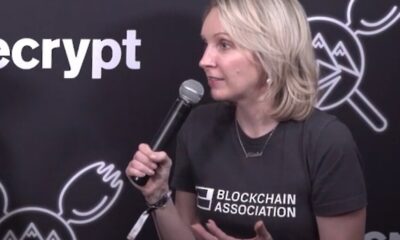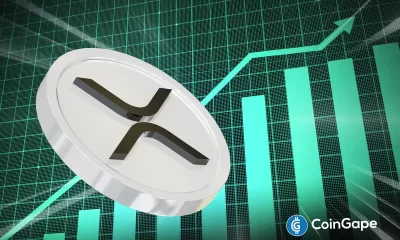HodlX
Beyond Blockchain – Top Companies Building on the Telegram Mini App Ecosystem
Published
4 months agoon
By
admin
Featured companies
Gamee – Making gaming social and accessible
Gamee – a popular mobile gaming platform – has cleverly leveraged Telegram’s massive user base by offering a diverse collection of casual games as mini apps.
This strategic move provides Telegram’s users with easy access to quick and engaging gaming experiences without ever leaving the app.
Gamee’s mini apps are designed with a mobile-first approach, catering perfectly to Telegram’s predominantly mobile user base.
Moreover, the social nature of Telegram enhances the gaming experience, allowing friends to compete and share scores within groups and channels, further solidifying Telegram’s position as a versatile platform for both communication and entertainment.
BingX – Pioneering copy trading on Telegram
BingX – a global cryptocurrency exchange – has launched a game-changing Telegram mini app designed for copy trading.
Copy trading allows users to follow top cryptocurrency traders and copy their trades directly within Telegram, without the need for additional downloads or lengthy registration processes.
The TON Space wallet lets users effortlessly deposit funds and explore BingX’s ‘copy trading plaza,’ enjoying the best of both worlds with Telegram and Web 3.0 space.
Wikipedia – Knowledge at your fingertips
Integrating Wikipedia, the free encyclopedia, as a mini app within Telegram brings a wealth of information directly to users’ fingertips.
This seamless integration allows users to access and share knowledge without needing to switch between apps, making conversations more informative and research more efficient.
The Wikipedia mini app serves as a valuable tool for educational purposes, enabling users to quickly look up facts, explore new topics and deepen their understanding of the world around them – all while staying connected within the Telegram environment.
BNB Chain – Expanding Web 3.0 accessibility
The BNB Chain has integrated with Telegram’s mini apps to further lower the entry barriers into Web 3.0.
By offering direct access to DApps (decentralized applications) and blockchain services through Telegram, BNB Chain simplifies crypto management for both Web 3.0 and Telegram users.
This move is expected to attract a broader audience by allowing them to manage assets and interact with DApps in a user-friendly, familiar environment.
Developers also benefit from streamlined integration via Privy’s SDK, allowing them to leverage Telegram’s massive user base with minimal friction.
TADA – Bringing ride-hailing to Web 3.0
Southeast Asian ride-hailing platform TADA has also joined the mini app movement, launching a feature that allows users to book rides directly through Telegram and pay using Toncoin or USDT on the TON blockchain.
TADA’s partnership with the TON Foundation highlights the growing collaboration between Web 2.0 and Web 3.0 platforms.
This venture not only simplifies ride-hailing but also helps users experience the benefits of blockchain without the hassle of new sign-ups or app downloads.
TADA is poised to expand its service regionally, bringing Web 3.0 solutions to a broader audience in Southeast Asia.
Bitget – Simplifying Web 3.0 engagement
Bitget is making waves with the launch of its Telegram app centre, a hub featuring over 600 DApps.
Bitget’s Telegram blockchain platform offers users seamless access to airdrops, play-to-earn games and Web 3.0 communities without the friction typically associated with blockchain technology.
Integrated within the Telegram Open Network (TON), Bitget’s platform simplifies blockchain interactions and bolsters the TON ecosystem’s growth, which now has a TVL (total value locked) of $425 million.
This initiative aligns with Bitget’s broader strategy of driving blockchain adoption, as reflected in its $20 million T?? ecosystem fund.
Zoom – Streamlining communication and collaboration
While not a complete replacement for the full Zoom platform, Zoom’s presence on Telegram as a mini app enhances the communication experience for users who rely on both platforms.
This integration allows users to seamlessly schedule and initiate Zoom calls directly within Telegram, eliminating the need to juggle between applications.
By streamlining the process of starting and joining Zoom meetings, the mini app adds another layer of convenience for Telegram users who value both its messaging features and Zoom’s video conferencing capabilities, further bridging the gap between different communication needs.
CyberCharge – Revolutionizing energy distribution
Blockchain-driven energy platform CyberCharge has introduced its own Telegram mini app, aiming to expand its decentralized energy networks to over 20 million Web 2.0 users.
The mini app provides a seamless gateway to energy transactions with Telegram blockchain integration, allowing users to participate in energy production and trading without the need for intermediaries.
Much like how Bitcoin disrupted traditional finance, CyberCharge is leveraging blockchain to decentralize energy systems, making energy markets more equitable and transparent.
This is a significant step toward their mission of democratizing global energy distribution.
Gate.io – A $10 million investment to support TON development
Gate.io has made a strategic $10 million investment into the TON blockchain, launching a CeFi-driven Telegram mini app and integrating its Gate Wallet into the messaging platform.
This move not only supports TON’s governance and development, but it also positions Gate.io as a key player in the Web 3.0 space.
By participating in the TON Society’s Hackers League and fostering innovation within Telegram-based projects, Gate.io is contributing to the widespread adoption of blockchain technology.
Conclusion
The examples above highlight the versatility of Telegram mini apps and their potential to enhance user experiences across various domains.
As more companies recognize the benefits of this technology, we can expect to see even more creative applications emerge.
The key takeaway is that mini apps are not just about blockchain or crypto – they are about leveraging Telegram’s strengths to provide seamless and engaging experiences for users in any industry.
Whether it’s gaming, knowledge sharing, communication or accessing essential services, mini apps are transforming how we interact with businesses and information within the Telegram ecosystem.
Nic Tse is an ex-journalist, writing and editing in the fintech, lifestyle and media spaces since 2012. He’s now covering Web 3.0, blockchain, and crypto stories for aelf, a layer-one AI-enhanced blockchain.
Follow Us on Twitter Facebook Telegram

Disclaimer: Opinions expressed at The Daily Hodl are not investment advice. Investors should do their due diligence before making any high-risk investments in Bitcoin, cryptocurrency or digital assets. Please be advised that your transfers and trades are at your own risk, and any loses you may incur are your responsibility. The Daily Hodl does not recommend the buying or selling of any cryptocurrencies or digital assets, nor is The Daily Hodl an investment advisor. Please note that The Daily Hodl participates in affiliate marketing.
Generated Image: Midjourney
Source link
You may like


Kristin Smith Steps Down as Blockchain Association CEO to Lead Solana’s Policy Push


crypto eyes ‘good news’ amid fragile market psychology


Bitcoin Price (BTC) Rises Ahead of President Trump Tariff Announcement


XRP Price to $27? Expert Predicts Exact Timeline for the Next Massive Surge


Grayscale files S-3 for Digital Large Cap ETF


279% Rally in 2025 for One Under-the-Radar Altcoin ‘Very Likely,’ According to Crypto Analyst
HodlX
Altseason Canceled? How Trading Syndicates, Scams and Geopolitics Buried Hopes for Growth
Published
1 month agoon
February 25, 2025By
admin
HodlX Guest Post Submit Your Post
Today, the cryptocurrency market resembles a theatrical performance in which insiders write the script and unsuspecting retail investors play the roles of the extras.
While altcoins are falling, meme coins turn into minefields and liquidity remains locked in exchange-traded funds (ETFs), institutions are accumulating Bitcoin but aren’t injecting free Tether and fiat into other assets.
Behind all of this lies a new wave of manipulations involving Solana cartels, insider-driven pump-and-dump schemes with worthless tokens, the absurdity of artificial intelligence (AI) agent trading and the epic dump of the TRUMP, MELANIA, LIBRA and BROCCOLI tokens.
These patterns highlight the ongoing challenges of market transparency and stability, making it increasingly difficult for investors to navigate the space with confidence.
This article contains only a market overview and does not provide any financial recommendations.
The current market situation
The market has been moving in a pretty expected way. BTC bounced back quickly but couldn’t reach a new all-time high, so it started slowing down again.
Normally, if Bitcoin’s dominance dropped, altcoins might have had a chance to rise. But aside from a few short-lived spikes – like ETH trying to break out – there hasn’t been any major shift.
As a result, altcoins look so weak that memes about their collapse are spreading across the industry, creating the impression that not only professionals but even beginners have lost faith in an altseason.
Most investors’ portfolios are deeply in the red.
Adding to the uncertainty is the geopolitical situation. Institutional investors remain on edge, fearing that the world is on the brink of a major conflict.
This has driven large players to actively buy gold, which has been setting new ATHs (all-time highs) over the past two weeks.
This trend indicates that capital is flowing out of risky assets, including crypto, and into safe-haven assets like precious metals.
The liquidity crisis
The key issue now is a real liquidity crisis. High-profile scams, mass liquidations and hype-driven sectors – memecoins, AI tokens, etc. – have absorbed enormous amounts of capital, concentrating money in the hands of major players.
Here’s what we see in the market.
- Liquidity frozen in ETFs – A significant portion of capital is locked in spot ETFs, limiting its circulation in spot markets.
- Retail exhaustion and regulatory pullbacks – A series of sharp sell-offs and scams, such as the recent incidents with TRUMP and Argentina’s presidential token LIBRA (which saw over $250 million lost), have severely damaged trust and reduced market activity.
- Capital outflows to traditional assets – While crypto faces a crisis of confidence, gold is setting new ATHs, and the stock market continues to attract institutional investors.
- Ongoing liquidity squeeze – Altcoins increasingly fail to meet expectations, and instead of a new growth cycle, we see a systematic transfer of retail investors’ funds into the hands of large players.
- Memecoins and AI tokens – After explosive growth in 2023, they are now experiencing brutal crashes, with price drops of over 90% becoming the norm.
Amid this, market stability is weakening, especially in the DeFi sector, which critically depends on liquidity.
Systematic liquidity manipulation in the memecoin market
Just as the dust was settling from the LIBRA and KSA scams, the market faced another case of speculative manipulation, this time with the Broccoli token.
Named after CZ’s dog, the Broccoli token became yet another example of how crypto market manipulation continues to enrich insiders while leaving retail investors with losses, further eroding trust in the space.
Key stages of the scheme
- Artificial hype creation – Limited liquidity and aggressive marketing fueled a rapid price surge.
- Peak pump phase – More traders joined in, attracted by rising prices and social media buzz.
- Sharp collapse – Insiders dumped their holdings, took profits and crashed the token’s price.
This case confirms that the market remains highly vulnerable to speculative strategies by large players, who exploit hype cycles to generate short-term price movements.
Conclusion
The market is now balancing between two opposing forces.
On one hand, it has been drained by mass scams, capital lock-ups in ETFs, geopolitical instability and overall industry fatigue from constant failures and fraudulent projects.
On the other hand, despite all the negative factors, the crypto market has been through similar phases before.
Large players are reallocating capital, and while institutions remain cautious, they aren’t exiting crypto entirely.
However, if the current liquidity crisis drags on, we could see another wave of panic, especially if arrests and investigations around Libra escalate.
Yaroslav Kalynychenko is the head of marketing at Generis Web3 Agency and an expert in promoting crypto, fintech and innovative digital solutions.
Follow Us on Twitter Facebook Telegram

Disclaimer: Opinions expressed at The Daily Hodl are not investment advice. Investors should do their due diligence before making any high-risk investments in Bitcoin, cryptocurrency or digital assets. Please be advised that your transfers and trades are at your own risk, and any loses you may incur are your responsibility. The Daily Hodl does not recommend the buying or selling of any cryptocurrencies or digital assets, nor is The Daily Hodl an investment advisor. Please note that The Daily Hodl participates in affiliate marketing.
Featured Image: Shutterstock/Voger Design/Sensvector
Source link
HodlX
Web 4.0 – Blockchain and AI Will Usher In a More Humane and User-Friendly Web
Published
3 months agoon
January 8, 2025By
admin
HodlX Guest Post Submit Your Post
Web 2.0, as it’s known, introduced us to social media networks like Facebook and MySpace and platforms like YouTube that empowered everyday internet users to easily publish their content.
However, behind these exciting smartphone apps, embedded videos, and user-centric platforms, carefully constructed corporate frameworks tracked, analyzed, and monetized every user interaction.
Most of us already know about this manipulation and the threat of having our private data sold and potentially leaked to the public.
A more under-discussed legacy of Web 2.0 is the mental health implications of doomsday scrolling and the complex algorithms behind this construct that cause severe mental strain on many of us.
Web 2.0’s dark side
The Web 2.0 model isn’t all bad. Targeted ads allow users to discover products and services that provide tangible benefits to their lives.
However, in most jurisdictions, internet users don’t have an opt-in option for how and who uses their private data.
Even after the EU implemented the GDPR (General Data Protection Regulation) in 2018 to protect individual online rights and privacy, insiders believe relevant violations are prevalent at most tech companies.
In addition to complex algorithms that provoke emotional reactions that lead to scrolling addictions and mental burnout, state-sponsored and non-state actors actively manipulate newsfeeds with bots spewing propaganda.
Between the over-bombardment of ads, provocative content, and the blurring of real and fake and intentionally confusing interfaces, the average internet user suffers from ‘information chaos,’ which can lead to stress and anxiety for many.
While social scientists and academics have documented the impact of social media on mental health, little is being done to address information chaos and the burden of Web 2.0’s intense emotional aftertaste.
However, these factors continually result in chronic fatigue, depression and social isolation – contributing to a decline in overall quality of life.
Constantly waiting for content to load, slow response times on technical support and the mind-numbing toxicity of endless social media scrolling rob users of valuable time and energy that could be spent more productively or enjoyably.
Micro-stresses – which people probably don’t notice while online – can accumulate and lead to serious psychological and physical problems.
In some circumstances, this manifests similarly to effects caused by alcohol and drugs.
Since Web 2.0 works in opposition to the user’s best interest and in favor of Big Tech and other corporations, a fundamental change in how internet technologies are designed and implemented is desperately needed.
The introduction of blockchain technology and smart contracts added an element of decentralization that counters Big Tech power, ushering in the Web 3.0 era, using a token-based economy to incentivize participation.
While blockchain and Web 3.0 have achieved a lot, it may not be enough to compete with the Web 2.0 structure.
Blockchain plus AI equals Web 4.0
Web 3.0 does, however, provide an important building block for those advocating for an internet that puts user interests before corporate profit margins.
‘Web4’ aims to empower the user by relieving Web 2.0’s cognitive overload and mental burdens that leave a negative emotional impression.
Web 4.0 represents the natural progression of the internet – a developer-led revolution combining blockchain technology and smart contracts with powerful AI and AGI (artificial general intelligence) to improve user interactions with digital services.
With blockchain’s ability to facilitate secure data ownership and communication alongside diverse and rapidly advancing AI capabilities, Web 4.0 will free users from routine tasks while minimizing the stress factors associated with Web 2.0.
At the heart of this transformation is a global AI layer as the basis for Web 4.0, which will operate as a truly decentralized and open-source ecosystem where users have convenient access to a range of services and applications, creating a single integrated solution.
Access to Web 4.0 platforms, services or applications hinges on adhering to the ‘three seconds or three clicks’ principle ensuring any access to information or a task receives maximum efficiency.
Thanks to optimized AI-powered interfaces capable of anticipating a user’s needs, this principle ensures all services and applications within the Web 4.0 ecosystem are delivered fast without information overload.
By building off of Web 3.0’s decentralized principles and capabilities – which provide trust instead of centralization – and infusing it with advanced AI systems, Web 4.0 offers the promise of making our lives more efficient and less stressful.
Web 4.0 allows us to reimagine social media platforms that will only be able to operate if they eliminate intrusive ads, and excessive notifications and provide streamlined access to necessary information.
This vision offers users a new communication standard that doesn’t make them feel like they are in the middle of a corporate competition.
The overarching theme behind the Web 4.0 movement is building a human-centric online environment where any participating service must adhere to the principles of transparency, honesty, speed and stress minimization.
Decentralized development of ethical AI models and tools ensures safety and transparency, allowing a new internet paradigm to take shape.
By not only making information more accessible and tedious tasks easier to accomplish, Web 4.0 provides users with a faster, safer and more transparent source for internet interactions.
Web 4.0 envisions an internet where decentralization is achieved not only through blockchain but also through the integration of AI agents capable of performing specific, targeted tasks efficiently and without unnecessary overload or spam.
These intelligent agents will act as personalized assistants, seamlessly handling routine activities while ensuring a streamlined and stress-free experience for users.
This approach eliminates the intrusive and chaotic nature of traditional Web 2.0 systems, offering a cleaner, more purposeful interaction that respects user preferences and time.
Bringing about a true transition to Web 4.0 will prove difficult and may take time, but the growing synergies between blockchain, smart contracts and rapidly advancing AI tools offer hope.
Communicating and advocating for this user-centric technology will put pressure on Big Tech and governments to address the problems of Web 2.0, providing the necessary momentum to fuel a real Web 4.0 revolution.
Peter Ionov is the CEO and founder of GT Protocol. He is a Ukrainian entrepreneur, engineer and inventor who leads and runs several other companies including Robosoft and Ukr Reklama. Peter is paving the way in Web 4.0, robotics and AI.
Follow Us on Twitter Facebook Telegram

Disclaimer: Opinions expressed at The Daily Hodl are not investment advice. Investors should do their due diligence before making any high-risk investments in Bitcoin, cryptocurrency or digital assets. Please be advised that your transfers and trades are at your own risk, and any loses you may incur are your responsibility. The Daily Hodl does not recommend the buying or selling of any cryptocurrencies or digital assets, nor is The Daily Hodl an investment advisor. Please note that The Daily Hodl participates in affiliate marketing.
Featured Image: Shutterstock/jamesteohart/Natalia Siiatovskaia/Andy Chipus
Source link

Kristin Smith Steps Down as Blockchain Association CEO to Lead Solana’s Policy Push

crypto eyes ‘good news’ amid fragile market psychology

Bitcoin Price (BTC) Rises Ahead of President Trump Tariff Announcement

XRP Price to $27? Expert Predicts Exact Timeline for the Next Massive Surge
Bitcoin And Altcoins Fischer Transform Indicator Turn Bearish For The First Time Since 2021

Grayscale files S-3 for Digital Large Cap ETF

279% Rally in 2025 for One Under-the-Radar Altcoin ‘Very Likely,’ According to Crypto Analyst

Human Rights Foundation Donates 1 Billion Satoshis To Fund Bitcoin Development

Dogecoin, Cardano Lead Gains as Crypto Majors Rally

Fartcoin price surges 35% as recovery gains momentum

$1M Premium Paid for $70K Bitcoin Put Option

How DePIN’s Revenue Growth is Attracting Equity Investors – DePIN Token Economics Report

Bitcoin Poised For A Q2 Recovery? Analyst Points 2017 Similarities

Binance ends Tether USDT trading in Europe to comply with MiCA rules

Crypto Trader Warns of Potential 33% Dogecoin Drop, Unveils Downside Price Target for Ethereum

Arthur Hayes, Murad’s Prediction For Meme Coins, AI & DeFi Coins For 2025

Expert Sees Bitcoin Dipping To $50K While Bullish Signs Persist

Aptos Leverages Chainlink To Enhance Scalability and Data Access

Bitcoin Could Rally to $80,000 on the Eve of US Elections

Sonic Now ‘Golden Standard’ of Layer-2s After Scaling Transactions to 16,000+ per Second, Says Andre Cronje

Institutional Investors Go All In on Crypto as 57% Plan to Boost Allocations as Bull Run Heats Up, Sygnum Survey Reveals

Crypto’s Big Trump Gamble Is Risky

Ripple-SEC Case Ends, But These 3 Rivals Could Jump 500x

Has The Bitcoin Price Already Peaked?

A16z-backed Espresso announces mainnet launch of core product

Xmas Altcoin Rally Insights by BNM Agent I

Blockchain groups challenge new broker reporting rule

The Future of Bitcoin: Scaling, Institutional Adoption, and Strategic Reserves with Rich Rines

Trump’s Coin Is About As Revolutionary As OneCoin

Is $200,000 a Realistic Bitcoin Price Target for This Cycle?
Trending

 24/7 Cryptocurrency News5 months ago
24/7 Cryptocurrency News5 months agoArthur Hayes, Murad’s Prediction For Meme Coins, AI & DeFi Coins For 2025

 Bitcoin3 months ago
Bitcoin3 months agoExpert Sees Bitcoin Dipping To $50K While Bullish Signs Persist

 24/7 Cryptocurrency News3 months ago
24/7 Cryptocurrency News3 months agoAptos Leverages Chainlink To Enhance Scalability and Data Access

 Bitcoin5 months ago
Bitcoin5 months agoBitcoin Could Rally to $80,000 on the Eve of US Elections

 Altcoins2 months ago
Altcoins2 months agoSonic Now ‘Golden Standard’ of Layer-2s After Scaling Transactions to 16,000+ per Second, Says Andre Cronje

 Bitcoin5 months ago
Bitcoin5 months agoInstitutional Investors Go All In on Crypto as 57% Plan to Boost Allocations as Bull Run Heats Up, Sygnum Survey Reveals

 Opinion5 months ago
Opinion5 months agoCrypto’s Big Trump Gamble Is Risky

 Price analysis5 months ago
Price analysis5 months agoRipple-SEC Case Ends, But These 3 Rivals Could Jump 500x


